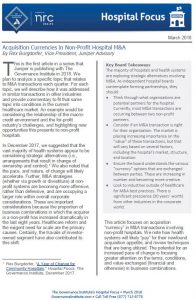Acquisition Currencies in Non-Profit Hospital M&A
 We note how health systems will likely “pay” for their newfound acquisition appetite, and review techniques that are being utilized. The potential for an increased pace of change is focusing greater attention on the terms, conditions, and value exchanged (financial and otherwise) in business combinations.
We note how health systems will likely “pay” for their newfound acquisition appetite, and review techniques that are being utilized. The potential for an increased pace of change is focusing greater attention on the terms, conditions, and value exchanged (financial and otherwise) in business combinations.
Regulators are placing a heightened emphasis on “fairness” and “thoroughness” in board decision-making processes. Historically, there was a large divide in the approach taken by for-profit companies, non-profit systems, and independent hospitals. Those differences have narrowed substantially.
Many “currencies” in non-profit business combinations are non-financial in nature. Transaction features to which value is often ascribed by non-profit sellers in M&A transactions include:
1. Debt obligations of seller assumed by buyer
2. Capital commitments—typically over a 10-year horizon, including both routine and strategic projects
3. Local input and control retained by seller via board seats on parent board
4. Retention of certain rights by seller over local operations
5. Board composition and mechanisms for local input
6. Creation of enforcement bodies to ensure compliance with terms
7. Mission, vision, and values continued by buyer
8. Commitments to religious or related ethical directives by buyer
9. Retention of existing charity care policies
10. Continued sponsorship and involvement in local community functions
11. Flexibility to use local contractors and vendors, when appropriate
12. Assurance that bequests, gifts, and donations are utilized for original intent
13. Balance sheet housed locally; financial assets not to be swept to buyer
14. Enduring use of name and brand
15. Service lines, accreditation status, and the like, uninterrupted
16. Corporate functions enhanced—recruiting, IT, legal, payer negotiations
17. Employees retained and protected